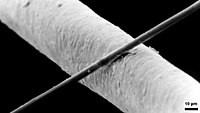
Photo from wikipedia
Abstract In current design practice for seismic resistant steel braced frames, general rules and standard provisions are aimed to ensure a structural behaviour for beam-to-column joints of non-braced spans as… Click to show full abstract
Abstract In current design practice for seismic resistant steel braced frames, general rules and standard provisions are aimed to ensure a structural behaviour for beam-to-column joints of non-braced spans as close as possible to perfect hinges. This is done to prevent any kind of interaction with the bracing systems, in particular under horizontal loads. However, the global performance of composite joints is markedly affected by the structural interaction between the concrete slab and the steel components and - especially during seismic events - struts can occur in the slab at the beam-to-column intersection. In this paper, the possibility of realizing a composite joint that behaves as moment-resisting under gravitational loads and essentially as hinged under horizontal loads is investigated. Aiming to assess the actual slab-interaction effects on the overall response, a full 3D Finite Element (FE) model representative of a beam-to-column composite joint taking part of a braced frame is described in ABAQUS and validated towards past full-scale experiments. A parametric study is hence proposed, by accounting for three geometrical configurations, being characterized by (i) isolated slab with absence of rebar continuity (i.e. fully disconnected slab and steel joint only), (ii) presence of slab with partial column interaction (i.e. isolated slab and continuity of rebar), (iii) presence of fully interacting slab. It is shown that, if properly detailed, a joint with isolated slab and continuous rebars can be used in non-braced spans of composite braced frames without affecting the behaviour of the bracing system (i.e. as in presence of a hinge). Nonetheless, the composite beam can be designed as continuous on multiple supports under vertical loads, hence leading to a reduction of the steel cross-sectional size.
Journal Title: Journal of Constructional Steel Research
Year Published: 2017
Link to full text (if available)
Share on Social Media: Sign Up to like & get
recommendations!